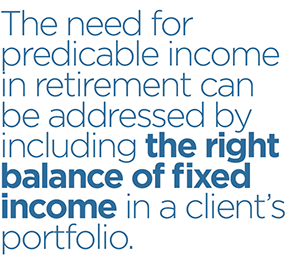With the Standard & Poor’s index up 12 percent for the year in 2014, last year’s equity markets offered great opportunities for you and your clients. Given this backdrop, it may feel natural to be laser-focused on stock for 2015, yet don’t forget the end-game of creating the right balance for clients between the potential upside of the equities market and the need for consistent future income. As you consider making changes to a client’s portfolios, make sure to fully explore what their risk capacity really is and find the right risk/reward balance.
Many investors took money out of fixed income vehicles like bonds, treasuries and money market securities in 2014. They also may have simply shifted funds that would have been invested in those vehicles in order to fund additional investments in equities. Investors felt that uncertainty about when interest rates would rise was a threat to bonds, so the shift to equities is understandable. These investors also may have unintentionally increased their risk exposure by focusing on the short term and taking money out of vehicles intended for long-term investing.
With the strong equity market performance and low interest rates, fixed income may seem less appealing. While the market remains strong, don’t neglect asking your clients the right questions and anticipating that the market could shift. Given this possibility, ask yourself if you are positioning clients for the long-term. Consider whether there’s an equity correction around the corner, when interest rates might rise and how falling oil prices might impact the market. While it’s impossible to know how these situations will unfold, portfolio diversification can help investors stay on track and keep an equity-focused portfolio from turning riskier than planned.
 We all know that as clients approach retirement, they should lower their risk profile. Because of this, it’s a common assumption that fixed income is just for older clients. While fixed income investments do make sense for older clients and it is important to adjust a portfolio allocation based on a client’s life stage, it is a mistake to think that fixed income investments have no place in the portfolios of younger clients.
We all know that as clients approach retirement, they should lower their risk profile. Because of this, it’s a common assumption that fixed income is just for older clients. While fixed income investments do make sense for older clients and it is important to adjust a portfolio allocation based on a client’s life stage, it is a mistake to think that fixed income investments have no place in the portfolios of younger clients.
When it comes to investing for the long term, having the right balance of fixed income could help your clients take advantage of today’s market environment, but also manage risk (and later, clients’ need for income). Ultimately, fixed income investments, like corporate bonds or annuities, should be viewed as long-term holdings designed to deliver a fixed stream of income. Remember though: you still need to be careful with credit default risk and interest rate risk when investing in bonds.
The key is to find the right balance for your client’s risk tolerance, as is true with any investment. Many clients may not realize a bond investment is beyond their risk capacity in chasing higher yields through riskier, lower rated bonds. You play a key role in helping your clients understand variances in the bond market. Higher rated individual bonds or bond funds have the potential to generate reliable income for clients. For your clients, investments should be looked at based on their objectives for long-term security and income streams. The need for predicable income in retirement can be addressed by including the right balance of fixed income in a client’s portfolio.
A portfolio that may serve your clients best over time should shift the allocation of bonds, equities, and other securities to address current risk appetite and anticipated future income needs. Annual review meetings or major life events, such as a new job, getting married or retirement, are critical times to review a client’s portfolio allocation.
While squirreling away money to reach a large retirement savings figure has historically been how investors prepared for retirement, a shift is occurring in which the focus has moved to assessing future monthly income needs in the context of savings and investments. Retirement readiness becomes a more actionable and attainable goal when savings are put in the context of a monthly paycheck in retirement. Voya Financial® research from 2014 found that knowing the future monthly income produced by savings would have a significant impact on confidence and control for more than 80 percent of working Americans. In an environment where traditional retirement income sources such as pensions are disappearing, fixed income vehicles can be a highly reliable source for funding a client’s retirement income stream.
There will be new economic realities to manage in 2015 – such as rising interest rates - so consider your clients’ portfolio balance carefully to help them on their path to retirement readiness. Be strategic in rebalancing clients’ portfolios, keeping fixed income options and the long-term plan in mind.
Tom Halloran is president of Voya Financial’s broker-dealer, Voya Financial Advisors, Inc.

